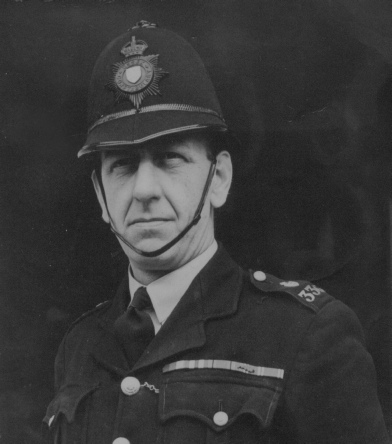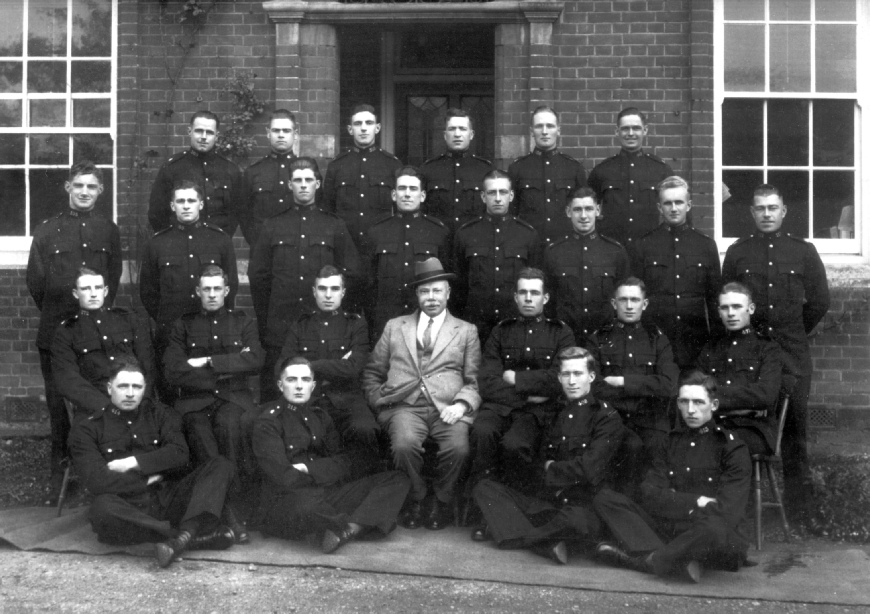
Memoirs of Peter Griffiths - Age 73
Son of PC 336 Ken Griffiths
Article by Richard Kirton 25 February 2012
PC 336 Ken Griffiths

I was so pleased that Peter Griffiths, the son of Pc Ken Griffiths agreed to travel down to Stambridge and give me some facts about his father. Peter had just tended his parent’s last resting place in the Stambridge Churchyard before joining me for some lunch in the Cherry Tree Public House. It transpired that Peter attended Southend High School for boys and left just before I joined. His father retired from Essex Police two years before I joined as a Police Cadet at Rochford Police Station. Peter’s career took a completely different tack taking him into teaching for about 20 years and then producing educational programmes for Thames Television. He spends his time now as a Genealogist and Family Historian and helps to organise Friends of the Old Barling School, a group of people who have connections with the Victorian building on Little Wakering Road.
PC 336 Ken Griffiths was born Leslie Hinchley Griffiths in Nottingham on 28th February 1911. It is not known how he came by the nickname of ‘Ken’. When he left school in 1925, he started work as an apprentice to his father, William Henry Griffiths, a cabinet maker. Ken was not happy with this work; so, in 1929, at the age of 18 years, he went to London and became a soldier. At 6ft 2½in tall he was proud of being the shortest man in the prestigious King’s Own Company, 1st Battalion, Grenadier Guards. He spent four years with the regiment, serving in London (including at Buckingham Palace and the Tower of London), Windsor and Egypt. Ken’s Record of Employment on leaving the Grenadier Guards in 1933 recorded him as being ‘Exemplary. An excellent man.’
On 15th September 1933, aged 22, Ken joined Essex Police, having trained in Chelmsford. (He is fourth from the right in the third row in the photo of his class.) His first posting was to Harwich in the Clacton Division and from there he moved to Brentwood. He played cricket for the Essex County Constabulary county team as well as various divisional teams.
He met his wife Vera in 1935. She lived at Aveley and was working in the office of Grays Co-op at that time. They married on 27th October 1937. Ken was transferred to Harlow Police Station and his son Peter was born there in 1939. Their other sons were John (Epping, 1942), Gerald aka Joss (Little Wakering, 1946) and David (Great Wakering, 1953).
With the onset of World War II in 1939, Ken was called back to the Grenadier Guards, but after some weeks was transferred to the Military Police, as the Army had less than a quarter of the MPs it needed. In April 1940 he went with 127 Infantry Brigade to northern France and then up to the Belgian border. When the Germans invaded Belgium, his outfit was part of the army that went to confront them. However, just before doing so, they received orders to retreat to Dunkirk. All this time Ken used a motor-bike when delivering despatches. He was among those rescued from Bray Dunes, near Dunkirk, on May 31st. Whilst in France and Belgium, Ken kept a Wartime Diary, even though this was forbidden, in case it fell into enemy hands. He wrote it from 4th April to 26th September 1940. Extracts from his diary can be seen here.
In 1943 Ken’s family moved to Little Wakering, which Ken got to visit whilst on leave from various barracks in the north of England. Sometime after D-Day, he was sent back to France and travelled up through Belgium, Holland and Germany. He finished his wartime duty in Schleswig-Holstein, helping to prevent Germans from fleeing to Denmark. He was demobbed from there in October 1945.
Ken re-joined his family and the Essex Police Force at his new posting at Little Wakering Police Office, a semi-detached house called ‘Ben Hur’, now 218 Little Wakering Road (on the left in the photograph). The Police Office was actually the front room of the house. Rather than take the two-week vacation to which he was entitled, Ken started work on the following Monday morning.
Up at Great Wakering Percy Hutton was the existing Police Officer and he lived in a private house in the High Street close to St Nicholas Church. He and Ken shared the beat for the next four years. Percy Hutton died in 1949 and for 18 months Ken was solely responsible for policing Foulness and the Islands, Little & Great Wakering, Barling and Shopland, covering the entire area on a bicycle.
In 1951 two brand-new police houses and an office were built in Great Wakering High Street and Ken and his family moved into No 288. They were followed not long after by PC John Marshall and his family at 290 High Street. When John left the Police in the mid-1950s, he was replaced by PC Alf Jowett.
Ken was on duty on the night of Saturday 31st January and Sunday 1st February 1953. He had cycled to the War Department police post at Landwick and was on his way back to Wakering when he saw the sea-wall break. That was the start of the terrible flooding that everyone in the area remembers. Some of Ken’s actions during that night and the following day are described in ‘The Great Tide’ by Hilda Grieve, published by Essex County council.
On the 8th March 1956 a headline in the ‘Southend Standard’ newspaper read ‘Service medal for Policeman’. The text read “At Southend County Sessions on Wednesday, PC Leslie Griffiths of Great Wakering was presented with a Police Long Service Medal for Meritorious Work by the chairman Arthur Bentall. The Chairman said “All law abiding citizens of this country have the highest regard for our Police Force. Their duties range from parking offences to the arresting of dangerous criminals. We have here PC Griffiths of Great Wakering, who comes from my home town and who has qualified for this medal. I can say from experience that PC Griffiths is a most courteous, discrete and efficient officer, and I am sure that he is well worthy of this award”. The paper included a further comment, which Ken was not so happy about: “Apparently, reading detective novels was not PC Leslie Griffiths idea of enjoying himself but lending him a book about the hardships suffered in prisoner-of-war camps made him happy”.
Ken retired on the 22nd July 1960 and on his record of service his conduct was described as ‘Exemplary’. He had to vacate the Police House and had been served by Police Sergeant W. Simpson on 27th June 1960 with the notice to quit. However, Ken and his family were still living there in January 1961. The solicitor for the County Council of Essex had to get involved to ensure eviction to free up urgently required accommodation for another Police Officer. I knew this Sergeant ‘Jock’ Simpson personally when I joined Rochford Police Station in 1962 and, according to Peter, he was a good friend of Ken Griffiths.
The Griffiths family left 288 High Street in early 1961 and, after a brief stay at the Castle Inn, moved to ‘Nulli Secundus’ in Barrow Hall Road. This house is the last house on the right leaving Little Wakering and is called ‘Greenways’ today (2012). A year later, in 1962, Ken and his family moved to Great Stambridge.
After leaving the Police Force, Ken worked for Aviation Traders at Southend Airport and retired from there in 1969/70. His last employment was in a wood yard at Wallasea Island. Ken died in 1998 on the same Thursday/Friday night as his wife Vera, but 2 years later.
When I parted company with Peter Griffiths it struck me that his father could be compared to the fictitious ‘Dixon of Dock Green’. In fact, the residents of Great Wakering during the 1940s and 50s could boast their very own ‘Griffiths of Great Wakering’.





© 2015 - Richard Kirton - All Rights Reserved | Privacy Policy | Terms of Use | Site Map

